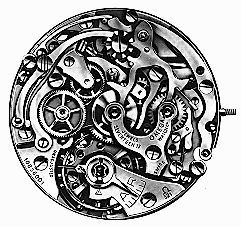
(Additions and coeerctions
welcome!)
by Joao R. Campos

The image you see above is the Omega 321 Caliber, the one tested by NASA which made the Speedmaster famous as the "Moon Watch".
Omega now is a marketing organization owned by the SMH group (Swatch). Today Omega S. A. "manufactures" watches the same way NIKE "manufactures" sneakers = Nike never operated a single shoe factory anywhere.
Omega of the old times went
bankrupt in the mid eighties during the turmoil that swept Swiss
watch industry with the introduction of the quartz watch. With the
country's two largest watchmakers - ASUAG and SSIH - (SSHI was
the
parent company of OMEGA S.A.)
nearly insolvent, Swiss banks turned to Zurich-based Hayek
Engineering, headed by Nicholas G. Hayek, to conduct an analysis of
the situation to avoid folding. Hayek planed a series of co-ordinated
mergers and reorganizations that resulted in the SMH/Swatch Group
being born (details on note at the end of this article).
Now Omega buys its
movements from high volume movement manufacturers, like ETA and
Valjoux, gives them
an "Omega Caliber number" and
sell them under various Omega's traditional brand names. This is how
most of the formerly independent Swiss watch manufacturers operate
today, exceptions becoming fewer and fewer (and VERY
expensive).
Omega watches can be said
to be good quality mass-produced watches, built with ETA or Valjoux
moments produced at high volumes. Gone are the days, in the glorious
40's and 50's, when "régleur" A. Jaccard would win the Geneva
Observatory competition by regulating an Omega watch to beat all 4
entries of Patek Philippe and the single entry of Rolex
(5th place).
The quartz revolution caused the premature retirement of most "régleurs" and the disappearance of the "personalized" watch movements in all but the extremely high price ranges. The "personalization" of watches nowadays consists only in the personalizing the style of the cases. Watches of several different manufacturers, in completely different price ranges, run with the very same ETA or Valjoux movement.
Omega made chronographs
since 1912. In 1932 it began to buy the "ébauches" (or rough
movements) from Lemania,
in L'Orient, at the Lake
Geneva. In 1946 it perfected Caliber 27 CHRO, made with Lemania
ébauches. From 1957 on, OMEGA sold the chronograph caliber 321
(which was the evolution of Caliber 27 CHRO C12, also called Lemania
2310, or Omega 321) as the "Speedmaster". This was the very caliber
that was tested by NASA and which is reported to have achieved
"unbelievable results" and caused Omega to be chosen as the official
astronaut watch in 1965. Since 1966 the Speedmaster received the
surname of "Professional" . In 1968 the production of famous caliber
321 was discontinued, being
replaced by caliber 861. It
had a newly developed sturdy control lever mechanism in the Landeron
style (without column wheel), glycidur balance, eccentric fine
regulation, a frequency of 21,600 half oscillations per hour (instead
of the previous 18,000).
It is not clear to me if
the actual watch that Neil Armstrong was wearing when he landed July
21st, 1969 on the
moon was fit with the "new"
little tested 861 caliber. I tend to believe NASA used the already
tested 321 in this first mission.
My references are
contradictory. The "Speedmaster Professional" was part of 50 space
missions, including 6 moon landings. In the later missions it is
certain that the "Speedmaster Professional" was fitted with the
caliber 861, so probably
both 321 and 861 have been on
the moon.
The NASA/Omega relationship
extended way into the 80's. In 1978 it again tested various watches
and the
Omega was chosen once more to
be the official astronaut's watch. In the early 1970's the
"Speedmaster Professional" was offered for the first time with an
automatic movement, using the jointly developed Omega/Lemania caliber
1040, 31mm diameter, day.
In 1973 Omega made a
special 125th anniversary Edition of the Omega Speedmaster
Professional, which was called "Omega Speedmaster 125". It used
caliber Omega 1041, which was the Omega cal. 1040 with an
Official
Chronometer Certificate. Its
dial layout was also somewhat different: it had a central minute
register, day window at 3 o'clock, subsidiary dial for hour registry
at 6 o'clock, 24 hour indication inside the subsidiary seconds dial
at 9 o'clock. It was adjusted in 5 positions and 5 temperatures and
had a different waterproof case, of the "plug" type. Some sources
report that only 1,000 watches of this special edition were made. In
1975 they offered Omega caliber 1045, the same as 1040 with day/date.
This ended the period of Omega/Lemania movements that started in
1932.
Calibers 1120 and 1140
followed, which are modified mass-produced ETA 2892-A2 with a
chronograph module
attached. IMHO 2892 (the
underlying watch movement for Omega 1120 -1140) is the best ETA
movement ever made. It is the evolution of legendary Eterna-matic
3000 Cal. 1466-U and was mostly developed "outside" ETA, by Eterna,
at the very end of the time in the Swiss watch industry when quality
still had precedence of costs or mass-producing
techniques.
Calibers 1151 and 1152
(found on the Seamaster Professional) are modified Valjoux Caliber
7751 and Omega
1154 is modified Valjoux
7750.
...To the best of my knowledge. Corrections and additions welcome!
1984 marks the
rapprochement between the two big Swiss watch groups:
The new company resulting
from the merger has taken the following names:
Nicholas G. Hayek was the
architect and founder of the Swatch Group and is now its
President.
More info at:
http://www.eta.ch/gesch_e.htm
http://www.cdf.org/issue/swatch.html
Return to menupage.